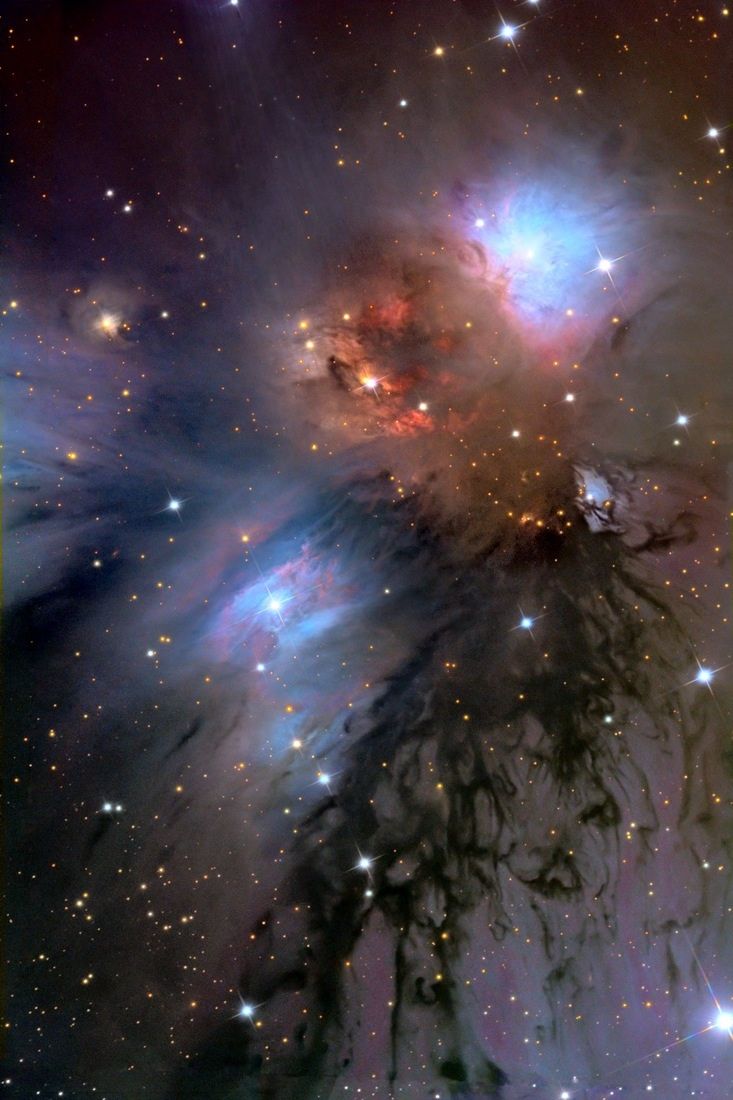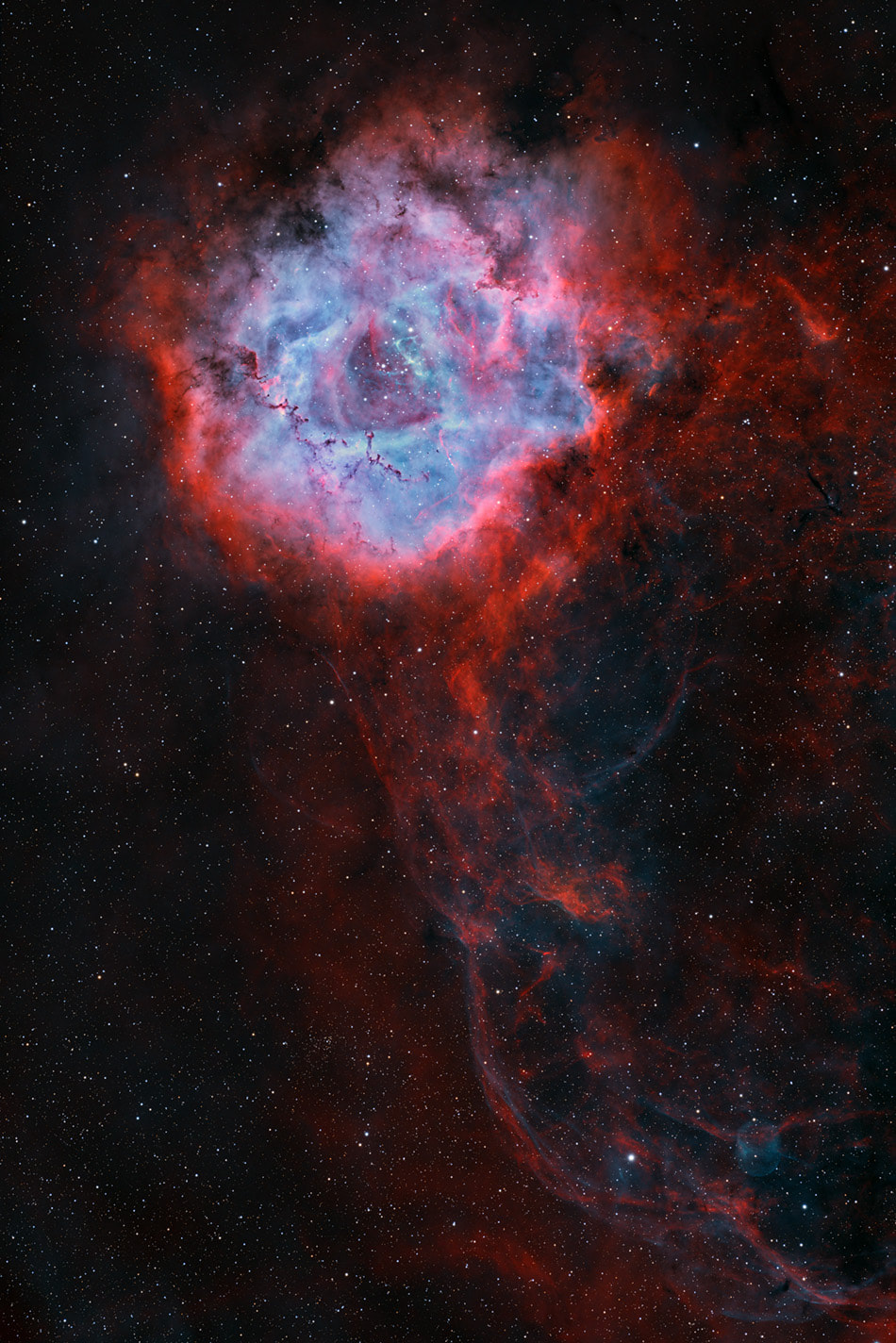Blog
Cora “Lovie” Austin (September 19, 1887 – July 8, 1972) was an American Chicago bandleader, session musician, composer, singer, and arranger during the 1920s classic blues era. She and Lil Hardin Armstrong are often ranked as two of the best female jazz blues piano players of the period.
She was born Cora Taylor in Chattanooga, Tennessee. Lovie grew up with eight brothers and sisters. She took the name Cora Calhoun in her teens from an early marriage; she was married for a short time to a movie house operator in Detroit and then later married a vaudeville performer, Phillip Austin. She studied music theory at Roger Williams University in Nashville, and Knoxville College in Knoxville, Tennessee which was uncommon for African American women and jazz musicians alike during the time.
more...NGC 2170 is a reflection nebula in the constellation Monoceros. It was discovered on October 16, 1784 by William Herschel.
Emily Remler (September 18, 1957 – May 4, 1990) was an American jazz guitarist, active from the late 1970s until her death in 1990.
Born in Englewood Cliffs, New Jersey, Remler began guitar at age ten. She listened to pop and rock guitarists like Jimi Hendrix and Johnny Winter. At the Berklee College of Music in the 1970s, she listened to jazz guitarists Charlie Christian, Wes Montgomery, Herb Ellis, Pat Martino, and Joe Pass. Remler bore the scars of her longstanding opioid addiction, which is believed to have contributed to her death. She died of heart failure at the age of 32 at the Connells Point home of musician Ed Gaston, while on tour in Australia.
more...
The Rosette Nebula (also known as Caldwell 49) is an H II region located near one end of a giant molecular cloud in the Monoceros region of the Milky Way Galaxy. The open cluster NGC 2244 (Caldwell 50) is closely associated with the nebulosity, the stars of the cluster having been formed from the nebula’s matter.
The complex has the following New General Catalogue (NGC) designations:
- NGC 2237 – Part of the nebulous region (Also used to denote whole nebula)
- NGC 2238 – Part of the nebulous region
- NGC 2239 – Part of the nebulous region (Discovered by John Herschel)
- NGC 2244 – The open cluster within the nebula (Discovered by John Flamsteed in 1690)
- NGC 2246 – Part of the nebulous region
The cluster and nebula lie at a distance of 5,000 light-years from Earth and measure roughly 130 light years in diameter. The radiation from the young stars excites the atoms in the nebula, causing them to emit radiation themselves producing the emission nebula we see. The mass of the nebula is estimated to be around 10,000 solar masses.

Makiko Hirabayashi (born 1966) is a Japanese jazz pianist based in Denmark. She started to play the piano at the age of four, and subsequently violin at nine. As a teenager, she became interested in composing film music and won a scholarship to Berklee College of Music in Boston, where she became more involved with jazz and improvisation. After graduation, she moved to Copenhagen to start her career as a pianist and composer.
Her compositions are inspired by elements from classical music, jazz, music from the Far East and the Nordic moods.
more...Lalgudi Gopala Iyer Jayaraman (17 September 1930 – 22 April 2013) was an Indian Carnatic violinist, vocalist and composer. He is commonly grouped with M.S. Gopalakrishnan and T.N.Krishnan as part of the violin-trinity of Carnatic Music. He was awarded Padma Bhushan by the Government of India in 2001.
His disciples included his two children Lalgudi G. J. R. Krishnan, Lalgudi Vijayalakshmi, his sister Lalgudi Srimathi Brahmanandam, renowned musician S P Ramh(grandson of Shri. G.N. Dandapani Iyer), musician P. Purnachander Rao, renowned Harikatha exponent Vishaka Hari, leading carnatic vocalist Saketharaman, Vittal Ramamurthy, Dr. N. Shashidhar, Film Music Composer Girishh G, Padma Shankar, Kanchan Chandran, Raghuram Hosahalli, Srinivasamurthy, Pakkala Ramdas, Sankari Krishnan, Yamini Ramesh, Mumbai Shilpa, Shreya Devnath, Krithika Natarajan, Salem Sisters, the leading Vainika Srikanth Chary and the Academy Award-nominated Bombay Jayashri Ramnath.
more...Hiram “Hank” Williams (September 17, 1923 – January 1, 1953) was an American singer, songwriter, and musician. Regarded as one of the most significant and influential American singers and songwriters of the 20th century, he recorded 55 singles (five released posthumously) that reached the top 10 of the Billboard Country & Western Best Sellers chart, including 12 that reached No. 1 (three posthumously).
Born and raised in Alabama, Williams was given guitar lessons by African-American blues musician Rufus Payne in exchange for meals or money. Payne, along with Roy Acuff and Ernest Tubb, had a major influence on Williams’s later musical style. Williams began his music career in Montgomery in 1937, when producers at local radio station WSFA hired him to perform and host a 15-minute program. He formed the Drifting Cowboys backup band, which was managed by his mother, and dropped out of school to devote his time to his career. When several of his band members were drafted during World War II, he had trouble with their replacements, and WSFA terminated his contract because of his alcoholism.
Williams married singer Audrey Sheppard, who was his manager for nearly a decade. After recording “Never Again” and “Honky Tonkin'” with Sterling Records, he signed a contract with MGM Records. In 1947, he released “Move It on Over“, which became a hit, and also joined the Louisiana Hayride radio program. One year later, he released a cover of “Lovesick Blues“, which carried him into the mainstream. After an initial rejection, Williams joined the Grand Ole Opry. He was unable to read or notate music to any significant degree. Among the hits he wrote were “Your Cheatin’ Heart“, “Hey, Good Lookin’“, and “I’m So Lonesome I Could Cry“.
Years of back pain, alcoholism, and prescription drug abuse severely compromised Williams’s health. In 1952, he divorced Sheppard and married singer Billie Jean Horton. He was dismissed by the Grand Ole Opry because of his unreliability and alcoholism. On New Year’s Day 1953, he suffered from heart failure and died suddenly at the age of 29 on the way to Oak Hill, West Virginia. Despite his relatively brief career, he is one of the most celebrated and influential musicians of the 20th century, especially in country music. Many artists have covered his songs and he has influenced Elvis Presley, Bob Dylan, Johnny Cash, Chuck Berry, Jerry Lee Lewis, George Jones, George Strait, Charley Pride, The Beatles and the Rolling Stones, among others. Williams was inducted into the Country Music Hall of Fame in 1961, the Songwriters Hall of Fame in 1970, and the Rock and Roll Hall of Fame in 1987. The Pulitzer Prize jury awarded him a posthumous special citation in 2010 for his “craftsmanship as a songwriter who expressed universal feelings with poignant simplicity and played a pivotal role in transforming country music into a major musical and cultural force in American life”.
Williams was born Hiram Williams on September 17, 1923, in the rural community of Mount Olive in Butler County, Alabama. He was the third child of Jessie Lillybelle “Lillie” (née Skipper) (1898–1955) and Elonzo Huble “Lon” Williams (1891–1970). Elonzo was a railroad engineer for the W. T. Smith lumber company and was drafted during World War I, serving from July 1918 to June 1919. He was severely injured after falling from a truck, breaking his collarbone and suffering a severe blow to the head. The family’s first child, Ernest Huble Williams, was born on July 5, 1921; he died two days later. They later had a daughter named Irene. Since Williams’s parents were both followers of Freemasonry, Williams was named after Hiram I.
more...Blind James Campbell (September 17, 1906 – January 22, 1981) was an American blues singer and guitarist. He is mostly remembered for his 1962–63 recording for the Arhoolie label with his Nashville Street Band.
James Campbell was born in Nashville, Tennessee, on September 17, 1906. He later became known as Blind James Campbell after an accident at a fertilizer plant left him permanently blinded. In 1936 he formed a band and began playing folk, country, pop, jazz and blues music at parties, dances and for other local events. The Nashville Street Band consisted of fiddler Beauford Clay (born 1900) who was a great influence on Campbell’s playing, second guitarist Bell Ray (born 1909), bass horn player Ralph Robinson (born 1885), and trumpeter George Bell.
more...Eugene McDuff (September 17, 1926 – January 23, 2001), known professionally as “Brother” Jack McDuff or “Captain” Jack McDuff, was an American jazzorganist and organ trio bandleader who was most prominent during the hard bop and soul jazz era of the 1960s, often performing with an organ trio. He is also credited with giving guitarist George Benson his first break.
Born Eugene McDuffy in Champaign, Illinois, McDuff began playing bass, appearing in Joe Farrell’s group. Encouraged by Willis Jackson in whose band he also played bass in the late 1950s, McDuff moved to the organ and began to attract the attention of Prestige while still with Jackson’s group. McDuff soon became a bandleader, leading groups featuring a young George Benson on guitar, Red Holloway on tenor saxophone and Joe Dukes on drums.
more...The Tarantula Nebula, also known as 30 Doradus, is more than a thousand light-years in diameter, a giant star forming region within nearby satellite galaxy the Large Magellanic Cloud. About 180 thousand light-years away, it’s the largest, most violent star forming region known in the whole Local Group of galaxies. The cosmic arachnid sprawls across this magnificent view, an assembly of image data from large space- and ground-based telescopes. Within the Tarantula (NGC 2070), intense radiation, stellar winds, and supernova shocks from the central young cluster of massive stars cataloged as R136 energize the nebular glow and shape the spidery filaments. Around the Tarantula are other star forming regions with young star clusters, filaments, and blown-out bubble-shaped clouds. In fact, the frame includes the site of the closest supernova in modern times,SN 1987A, at lower right. The rich field of view spans about 2 degrees or 4 full moons, in the southern constellation Dorado. But were the Tarantula Nebula closer, say 1,500 light-years distant like the Milky Way’s own star forming Orion Nebula, it would take up half the sky.

Earl Klugh (/kluː/ KLOO; born September 16, 1953) is an American acoustic guitarist and composer. He has won one Grammy award and thirteen nominations. Klugh was awarded the “1977” Best Recording Award For Performance and Sound” for his album “Finger Painting” by “Swing Journal” a Japanese jazz magazine.
At the age of six, Klugh commenced training on the piano until he switched to the guitar at the age of ten. At the age of thirteen, Klugh was captivated by the guitar playing of Chet Atkins when Atkins made an appearance on the Perry Como Show. Klugh was a performing guest on several of Atkins’ albums. Atkins, reciprocating as well, joined Earl on his Magic In Your Eyes album. Klugh also appeared with Atkins on several television programs, including Hee Haw and a 1994 TV special titled “Read my Licks”. Klugh was also influenced by Bob James, Ray Parker Jr, Wes Montgomery and Laurindo Almeida. His sound is a blend of these jazz, pop and rhythm and blues influences, forming a potpourri of sweet contemporary music original to only him.
more...Charlie Lee Byrd (September 16, 1925 – December 2, 1999) was an American jazz guitarist. Byrd was best known for his association with Brazilian music, especially bossa nova. In 1962, he collaborated with Stan Getz on the album Jazz Samba, a recording which brought bossa nova into the mainstream of North American music.
Byrd played fingerstyle on a classical guitar.
Charlie Byrd was born in 1925 in Suffolk, Virginia, and grew up in the borough of Chuckatuck. His father, a mandolinist and guitarist, taught him how to play the acoustic steel guitar at age 10. Byrd had three brothers, Oscar, Jack, and Gene “Joe” Byrd, who was a bass player. In 1942, Byrd entered the Virginia Polytechnic Institute and played in the school orchestra. In 1943, he was drafted into the United States Army, saw combat in World War II, and was stationed in Paris in 1945. There he played in an Army Special Services band and toured occupied Europe in the all-soldier production G.I. Carmen.
more...More Posts
- The Cosmos with M16
- Eric Dolphy Day
- Lazy Lester Day
- World Music with Obo Addy
- Daily Roots with Bob Marley
- The Cosmos with Fleming 1
- Ernest Ranglin Day
- Billy Drummond Day
- World Music with Lela Tataraidze
- Daily Roots with the Skatalites
- The Cosmos with NGC 6872 & IC 4970
- Paul McCartney Day
- William Hooker Day
- Rudy Rutherford Day
- World Fusion with Manika Kaur
- Daily Roots with the Congos
- Happy Fathers Day 2018
- The Cosmos with RCW 108
- Chuck Rainey Day
- Sing Miller Day